Description of indoor pomegranate and its cultivation
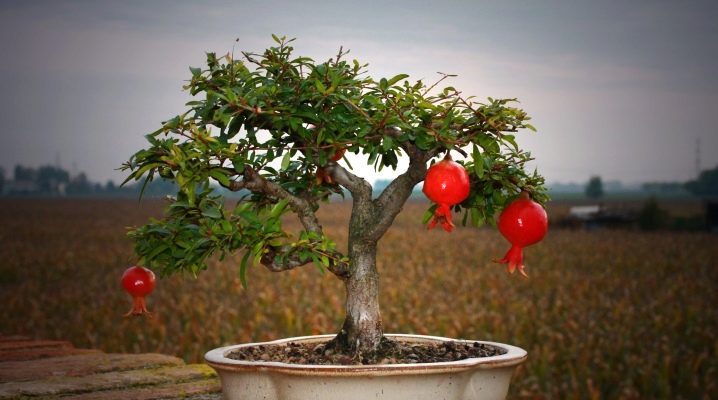
A variety of fruits allows not only to make the diet complete, but also to fill the body with useful and necessary vitamins and minerals. Pomegranate is a valuable fruit that is recommended for both adults and children, but it is sold seasonally and can cost a lot of money. In order to always have such a valuable fruit and a beautiful culture at hand, you can grow it at home. For successful cultivation, it is necessary to know the characteristics of the process and the most suitable varieties.

Description
Pomegranate is an exotic fruit that grows massively in the Caucasus and Central Asia, and is also distributed in other Asian countries and around the Arabian Sea. The fruit got its name because of its granular structure, which in Latin sounds like Granatus. Since ancient times, people have seen benefit and value in this culture, therefore they have cultivated and grown in suitable territories.
In nature, the pomegranate tree has a height of 5-6 meters and produces fruits 8-12 cm in size, indoor pomegranate is much smaller: it is a shrub 0.5 to 2 meters in size, on which fruits with a diameter of 5-7 cm can grow. In addition to valuable fruits, this plant is also grown for its decorative appearance: the crown is spreading, and the trunk is even and slender.
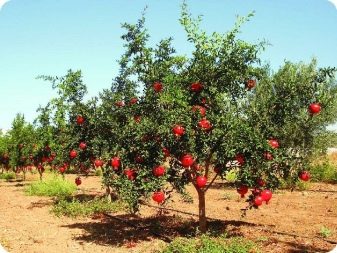
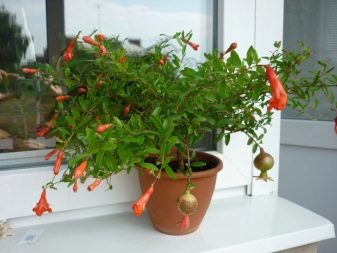
The culture blooms with beautiful orange funnel-shaped flowers. This period begins in May and ends in September. Each flower retains its attractiveness for 3-5 days, after which it withers, and a new one appears in its place. Thanks to this method of flowering, the plant is in bloom for six months, which pleases the eye.
With proper cultivation and compliance with all rules and regulations, after 3 years, you can get the first harvest of pomegranates. The fruits begin to ripen by the end of autumn. Growing such a room crop in a pot allows you to get a beautiful plant that can also give you healthy fruits.
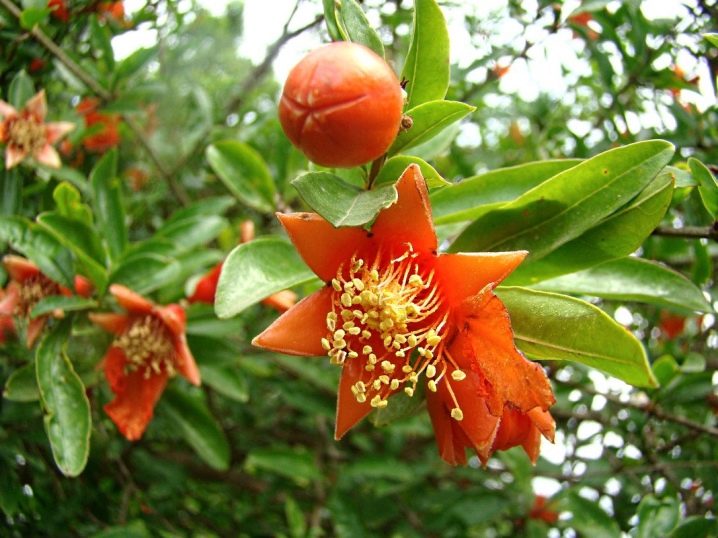
Variety selection
To breed pomegranates at home, they use dwarf varieties that do not take up much space and are not inferior in their attractiveness. Common pomegranate in nature has significant dimensions, therefore its cultivation in greenhouses and apartments will be impossible, but indoor varieties will not take up much space and will delight the eye.
Among the most suitable for growing at home are the following varieties.
- "Baby" - a dwarf variety of pomegranate, the bush grows up to 1.5 m, but often has a height of 50 cm.The leaves are characterized by an elongated shape and are evenly distributed throughout the bush. The culture blooms in 3-4 years. The flowers are large and red in color. The size of the fruits is from 5 to 7 cm, they ripen in winter. The skin of the fruit is brownish with a red tint.

- "Uzbekistan" - a tall indoor plant variety, reaching 2 meters in height. Suitable for greenhouses or large spaces. The fruits have a bright red hue, pleasant taste and weigh from 100 to 120 g.

- "Ruby" - a low plant, reaching 70 cm in height. This variety is appreciated by gardeners for its ease of care and bright flowering for a long time. The flowers have a ruby hue. The fruits are quite large, up to 8 cm in diameter, their weight can be 100 g.
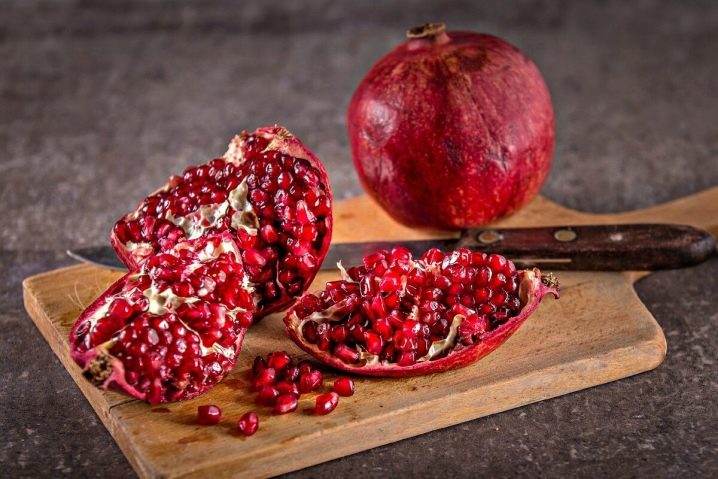
- "Nana" - a dwarf plant, not exceeding 70 cm, blooms from the first year of planting, has aesthetic qualities.The formation of flowers begins within six months after planting, and a full harvest can be obtained in the second year. By winter, this culture almost does not throw off its foliage, which is atypical for such plants.
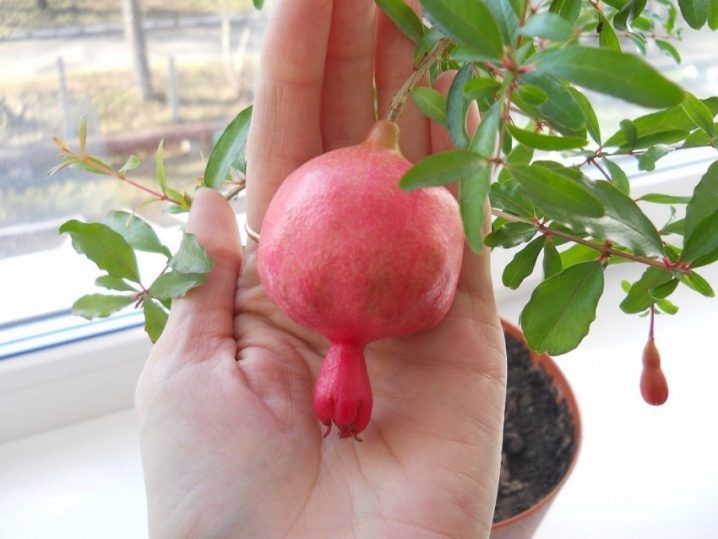
- "Carthage" - a plant that reaches a meter in height, is valuable for its decorative qualities, has beautiful and fragrant red flowers. The flowering period is from May to August. Fruits in small fruits 5-6 cm in size, which have a sour, but pleasant taste.
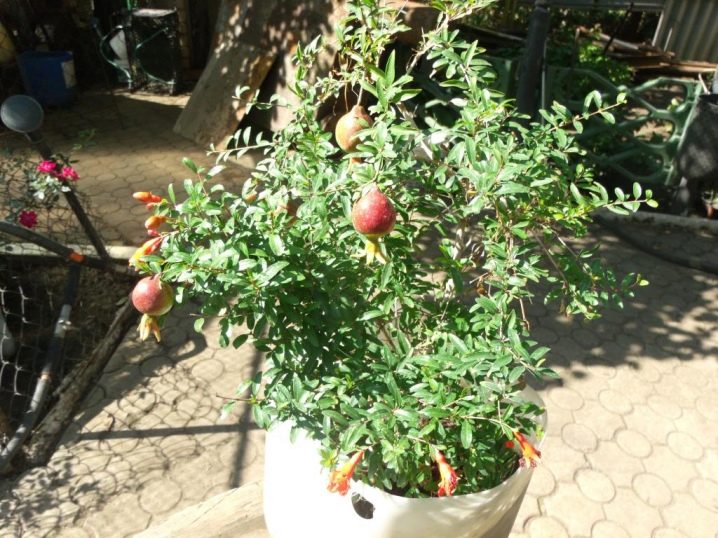
With proper care, you can get a decorative fruiting tree.
Landing
There are many ways to grow pomegranates at home, but the simplest is to use seeds. There are different varieties of pomegranate grains on sale, so you need to know exactly which option is suitable for home cultivation. An alternative would be to plant seeds from a purchased fruit, but the result will not always be the same, because they often sell hybrids that do not retain their qualities when planting. In addition, with this method of planting, the fruits will appear no earlier than 5 years later, but the decorative effect of the shrub itself will be very high.
It is worth planting seeds in February or early March, then the sprouts will appear after a couple of weeks. If you are late with this, you will have to wait several months. There should be no pulp on the seeds before planting, they must be clean, it is recommended to rinse them and place them in a solution with growth stimulants. The seeds should be in this composition for a day, the place should be dark, without drafts. If water begins to evaporate, it must be topped up. It should only cover half of the seeds to provide nutrition and preparation for planting.
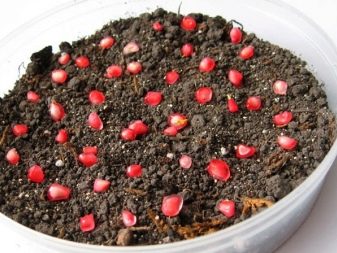
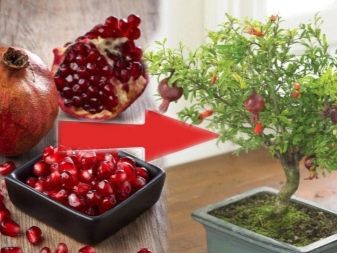
The soil for the pomegranate needs a universal one, which is sold ready-made in stores. In addition, you can independently create the soil for a future culture, for which they mix in equal proportions:
- peat;
- sand;
- fertile land.
To ensure the protection of future crops from contamination, the soil must be treated. The finished mass must be distributed on a baking sheet, pour a little water and put in an oven preheated to 80 ℃ for 30-40 minutes.

You can grow pomegranates both in pots and in containers. At the bottom of the planting container, it is necessary to pour brick chips, expanded clay or pebbles with a centimeter layer, and then distribute the soil itself. The prepared seeds are laid out on paper and dried, after which they are placed in the ground at a depth of 0.5-1 cm.
The planting is watered with water from a spray bottle, and the container is covered with glass or film. The pots are placed in a lighted place where the air temperature is + 23-25 ℃. In such conditions, the seeds remain until the first shoots appear.
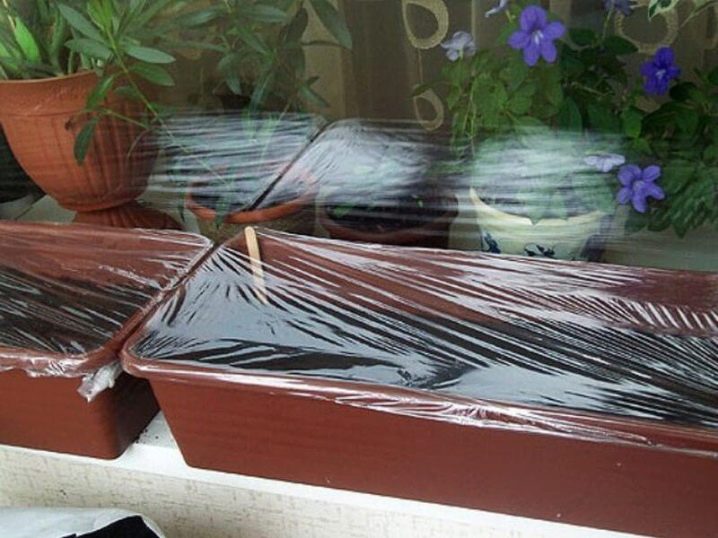
Care
Growing a pomegranate at home involves following a series of activities that will allow the seeds to germinate, form a beautiful crown and wait for the fruits. It is necessary to care for the crop from the first day of planting seeds. The soil should be sprayed from a spray bottle, the soil should not be allowed to dry out. As soon as the first shoots appear, it is necessary to start hardening the plant. Glass or film is removed from the container in which the pomegranate grows. The time of such procedures should increase gradually, you need to start from an hour a day.
From the moment 2 full-fledged leaves grow on the seedlings, the sprouts must be planted in different containers. In the process of transplanting, it is necessary to cut off the roots of the sprouts a little and plant them in the same soil mixture that was prepared when sowing the seeds. When three pairs of leaves appear on the sprouts, it is necessary to pinch the top so that the lateral shoots go into growth, which will allow the future bush to form.
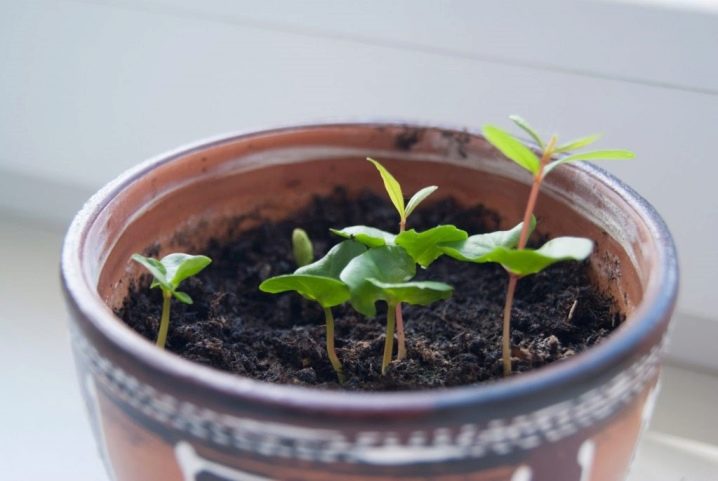
It is also necessary to pinch all new shoots on which three pairs of leaves have grown. Thanks to such actions, the crown is formed, the finished plant turns out to be voluminous, spreading and beautiful.
To grow pomegranate at home, it is necessary to create favorable conditions for the plant, for this you need:
- watering;
- fertilizer;
- pruning;
- treatment and prevention of diseases and pests;
- timely transplant.
For beginners, there are special workshops, written instructions explaining what and how to do to get the desired result.
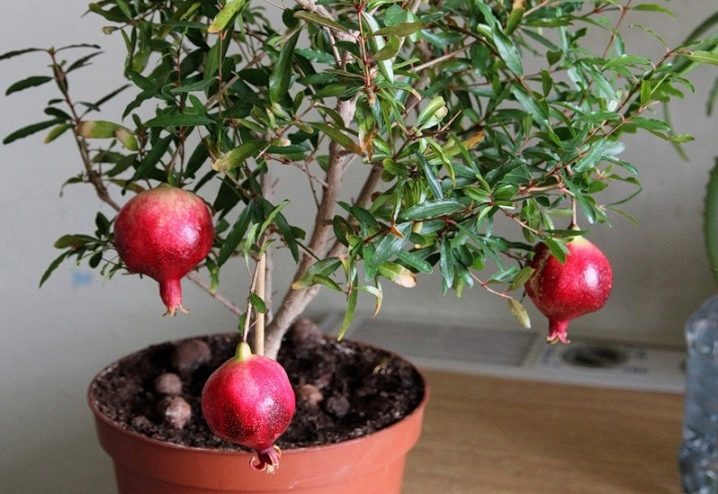
Conditions
To grow a beautiful dwarf pomegranate at home, you need to create a favorable habitat for it. The optimum temperature for the spring period for the crop will be in the range of + 23-25 ℃. With an increase in the indicator, it is worth taking the pot out to the balcony or sprinkling the crown with cold water.
In order to have fruits on the bush by winter, it is necessary to place the pot in a cool place in the fall, where the temperature will not exceed + 14–16 ℃. From late autumn to spring, it is necessary to give the culture peace by placing it in a basement or room. with a temperature of + 10–12 ℃.
In addition to temperature, it is worth taking care of the presence of light. Pomegranate loves bright, but diffused lighting, therefore it is better to put the pot with it on the east or west windowsill. If you wish, you can place a container with a plant on the south window, but in the daytime you will need to hang gauze or a thin cloth over the bush to provide diffused light. If the windows are northern, then you cannot do without a specialized lamp for growing plants. The pomegranate must receive artificial lighting for 12 hours.
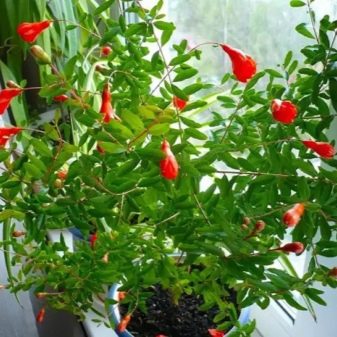
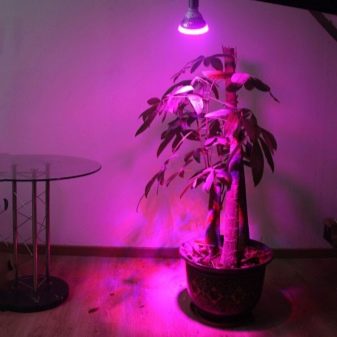
Watering
Pomegranate loves moisture, because you need to water the culture 4–5 times a week, adding a small amount of water, which will maintain the required liquid level and will not overmoisten the soil. When buds appear, the amount of watering is reduced, but the soil must be moist. Do not allow the soil to dry out. At the end of flowering, it is necessary to moisten the soil well and put the plant in a cool place until spring, creating conditions for the culture to rest. In winter, watering is carried out only once a week with a small amount of water.
For irrigation, settled filtered water is suitable. The water should be left alone for at least one day. Its temperature should be slightly higher than the air temperature.
In addition to the main watering in the warm season, the pomegranate also loves additional spraying. In spring and summer, you need to irrigate the foliage with a spray bottle daily, and on hot days - twice a day. This process stops for the winter.

Top dressing
Indoor pomegranate needs timely feeding, which will ensure the normal growth of green mass and subsequent fruiting. The optimal fertilizers will be mineral complexes that are used for flowering crops. If you want to get fruits from the bush, then you need to feed it with organic fertilizers. Chicken droppings or liquid manure are good in this case.
It is important to make top dressing on time and not to abuse their amount. If you use a lot of fertilizers, then the bush will quickly build up a green mass and will not give fruit ovary. If you use a concentrated organic solution, then you can burn the roots of the culture, as a result of which it will die.

Each season requires its own fertilizer. From February to June, nitrogen-phosphorus supplements are used, which are needed for proper nutrition of the culture and for laying a large number of buds. Fertilizers need to be applied once every two weeks, after watering, into moist soil. In autumn, instead of nitrogen supplements, it is better to use potassium.
When growing a shrub to get fruit, it is better not to use mineral fertilizers, but to limit yourself to organic... Suitable formulations required for the processing of fruit and berry crops.
You need to use fertilizers strictly according to the instructions, without increasing the dose and frequency of fertilizing, as this will only harm the culture.
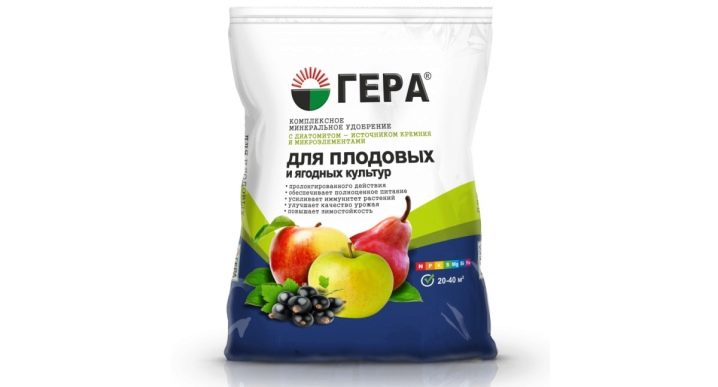
Pruning
The easiest way to grow pomegranates is from the seed; this option is more affordable and simpler. Bushes grown from seeds are not inferior in external indicators to plants planted in another way.Indoor pomegranate is grown not only for the sake of the fruit, but also for aesthetic pleasure. To get a beautiful bush, you need to be able to properly prune it. The pomegranate grows very quickly, and after a year you can get a tree, therefore it is necessary to be able to form a plant, giving it the desired shape.
The first pruning is carried out in February, during this period you need to remove the root growth and all dry, damaged and growing inward branches. A normal crown should have 4–6 main skeletal branches. Shoots are shortened so that they have 5 internodes. The cut must be done above the upper bud so that the branches do not intertwine. You can remove those shoots that have already borne fruit. Cuttings can be made from cut branches.
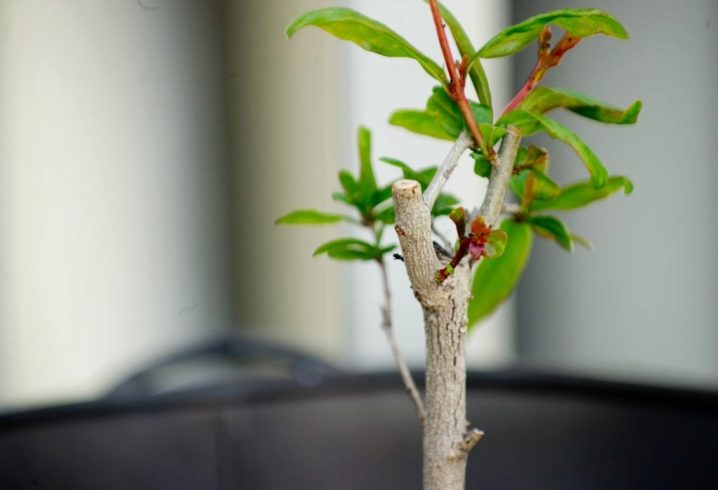
Transfer
Pomegranate trees grow very quickly, so they need to be transplanted into a new, larger pot every year. When the plant reaches 5 years of age, the procedure can be performed every 4 years. Adult crops can not be replanted, but it is necessary to replace the topsoil annually with a new, fertile one.
It is better to transfer pomegranates to a new place in February or March, when the plant moves away from dormancy. The pot must be ceramic or plastic. The new container should exceed the old one by 2–4 cm. The transplant process looks like this:
- prepare a new pot;
- it is good to fill in the soil in an old container with a plant;
- put drainage on the bottom of the new pot;
- take out the pomegranate along with the earthen lump and put in a new container;
- fill the free space with soil.
After transplanting, the bush remains without watering for several days, and then the previous schedule resumes.
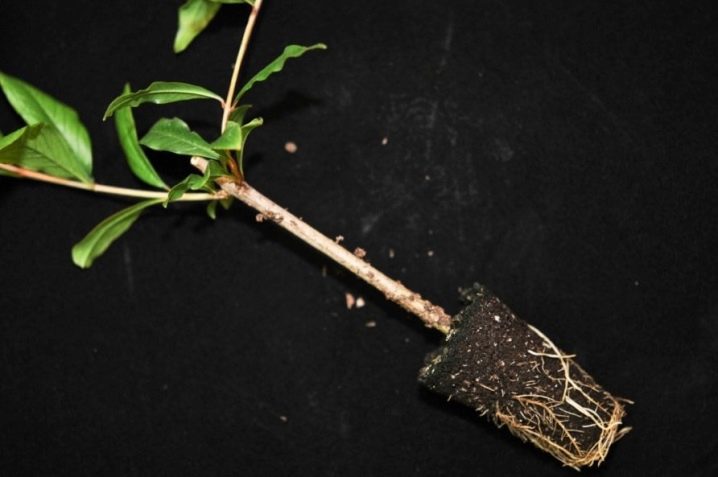
Reproduction
There are several ways to propagate pomegranates:
- using seeds;
- cuttings.
The latter option is more convenient, since it allows you to fully preserve the characteristics of the variety. The survival rate of cuttings is higher than that of seeds. To obtain this planting material, you need to cut a semi-lignified shoot 10-15 cm long, which will have 4-5 buds. You need to root the shoot in February. Before planting, the roots should be dipped in Kornevin's solution, a pair of lower buds are cut off on the handle, and it is placed in loose soil to a depth of 3 cm. It should be placed at an angle. Every day you need to water the soil, ventilate the room with the shoot, spray it. The rooted stem is transplanted after a few months.
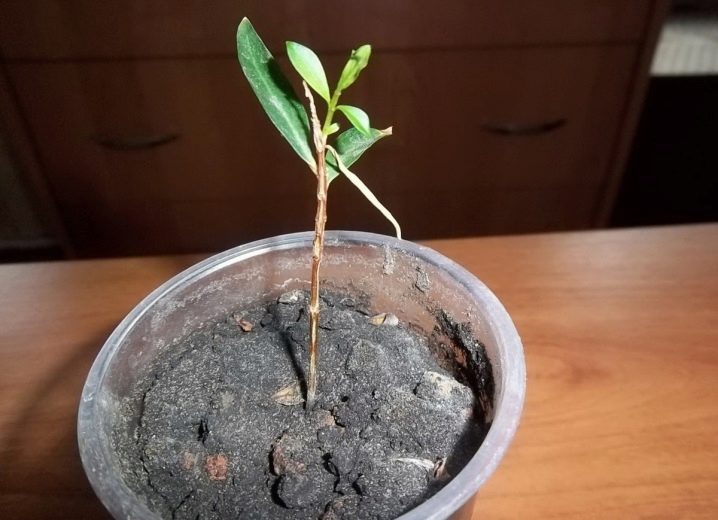
Diseases and pests
The pomegranate, like any other plant, has its own pests and diseases that can attack it. The main pests include:
- shield;
- spider mite;
- aphids;
- whitefly;
- mealybug.
Treatment of plants with soapy water helps to cope with the scourge. If the population is too large, you can use the drugs "Aktara", "Actellik", applying them three times with an interval of 5 days.
If you take proper care of the pomegranate, then he almost does not get sick. Sometimes it can be affected by branch cancer, which is manifested by cracks in the bark and swelling. For treatment, it is necessary to clean the affected areas to healthy surfaces and treat with copper sulfate, after which with garden varnish. If nothing is done, then the leaves turn yellow on the culture, gradually the bush dies.
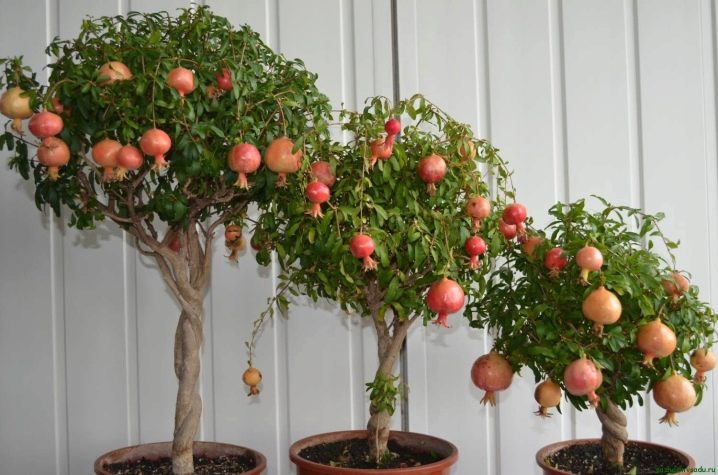































The comment was sent successfully.